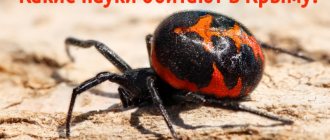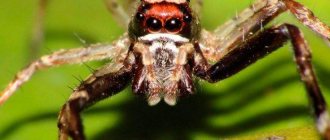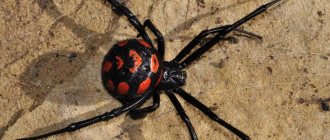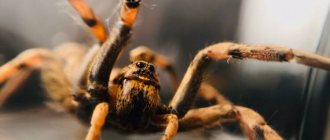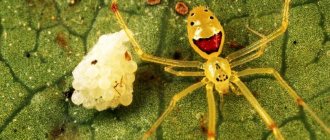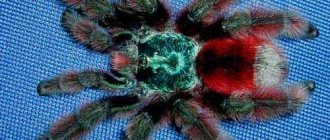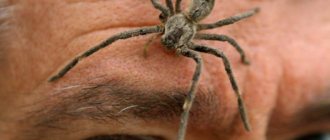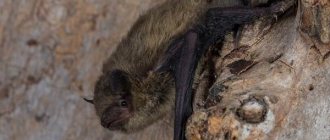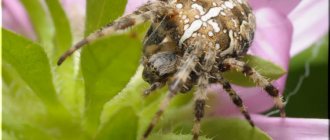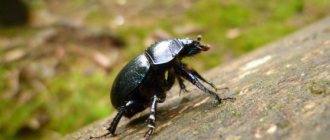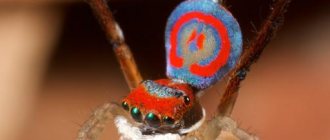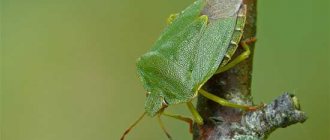- Wild animals
- >>
- Arachnids
The camel spider gets its name from its desert habitat. However, this animal is not a spider at all. Due to their similar appearance, they were classified as arachnids. The appearance of the creatures fully corresponds to their character. Animals are so voracious that they can eat until they literally burst.
Origin of the species and description
Photo: Camel spider
These creatures have many names - salpuga, phalanx, bihorka. The order Solifugae, to which they belong, means “running away from the light of the sun.” This is not entirely true, because among camel spiders there are quite a lot of sun-loving diurnal species.
Interesting fact: Africans called arthropods barbers or hairdressers. The population believed that the walls of the underground passages of salpugs were covered with the hair of people and animals, which they cut with their chelicerae (oral organs).
Some peoples call the phalanx "wind scorpions" due to their ability to move quickly. In England the popular names are camel spider, sun scorpion, wind scorpion, sun spider, in Tajikistan - calli gusola (bull's head), in southern countries - red romans, baarskeerders.
Video: Camel spider
Scientific names: Solpugida, Solpugae, Solpugides, Galeodea, Mycetophorae. The name “phalanx” is inconvenient for scientists because of its consonance with the Latin name of the order of harvestmen - Phalangida. The order includes 13 families, up to a thousand species and 140 genera.
The most famous representatives of salpugs:
- ordinary;
- Transcaspian;
- smoky.
The oldest find of the detachment dates back to the Carboniferous period. The species Protosolpugidae is now considered extinct and was described thanks to fossil remains found in Pennsylvania. Animals are found in Early Cretaceous deposits of Brazil, Dominican, Burmese, and Baltic amber.
Appearance and features
Photo: What a camel spider looks like
The structure of the phalanges is quite unique: it combines both highly developed and primitive features. The first includes the tracheal system - the most developed among arachnids. The second is the structure of the body and limbs. The appearance is a cross between spiders and insects.
Bihors are quite large animals; Central Asian species reach 5-7 centimeters in length, but some do not exceed 10-15 millimeters. The oblong body is covered with many long hairs and bristles. The color is dark yellow, sandy, whitish.
The anterior section of the body, on which the chelicerae are located, is covered with a large chitinous shield. The pedipalp tentacles often serve as forelimbs and look quite scary. Animals have 10 legs in total. Chelicerae look like claws or forceps. There is a pair of black eyes on the ocular tubercle; the lateral eyes are practically undeveloped.
If the forelimbs mainly perform a tactile function, then the hind legs have tenacious claws and suction cups, with the help of which the phalanges can easily climb vertical surfaces. The fusiform abdomen has 10 segments formed by the abdominal and dorsal parts.
Tracheal breathing is highly developed. It consists of longitudinal trunks and branched vessels with thickened walls in the shape of a spiral, which permeate the entire body of the salpug. The thick hair and quick movements help to repel enemies, as do the chelicerae, which look like crab claws and have the ability to make squeaking sounds.
The oral appendages are so strong that they allow arachnids to cut off hair, feathers and fur from victims, pierce the skin, and cut the bones of birds. Bubble shaped jaw ties. There are sharp teeth in the mouth. The tactile hairs of males are longer than those of females.
Black Widow
Black widow is a type of poisonous spider. It is dangerous for humans. You can recognize an arthropod by its black body. Females have a red, hourglass-shaped spot on their abdomen.
The spider is common in South and North America. Its size does not exceed 10 mm in females and 4 mm in males.
Black Widow: Wikipedia
The diet is based on small insects, centipedes and other spiders. The spider got its name because after mating the female often eats the male.
The black widow is the first to show no aggression towards humans. It can bite only in a hopeless situation. The spider's venom contains neurotoxins and quickly spreads through the victim's lymphatic system. As National Geographic notes, it leads to painful cramps, especially in the abdominal area. With timely treatment, a spider bite does not pose a threat to humans.
Where does the camel spider live?
Photo: Camel spider in the desert
Bihors are inhabitants of desert, arid, steppe areas with a tropical and subtropical climate. They can sometimes be found in temperate regions. Only a few species of phalanges have adapted to life in forests. The largest number is concentrated in the Old World. Representatives of the families Eremobatidae and Ammotrechidae can only be found in the New World.
In the Old World, arachnids are distributed throughout almost all of Africa, with the exception of Madagascar, in South, Western and Central Asia. Despite ideal habitat conditions, arthropods do not live in Australia and the Pacific Islands.
Several families live in the Palearctic, two endemics live in South Africa. The range also extends to India, Bhutan, Sri Lanka, Pakistan, and in Western Europe - the Balkan and Iberian Peninsula, Greece, Spain. Unsuitable living conditions do not allow inhabiting the Arctic and Antarctica.
In the countries of the former USSR, bihors live throughout Central Asia - in Tajikistan, Turkmenistan, Kazakhstan, Uzbekistan, Kyrgyzstan. They are found in Transcaucasia, the Northern Caucasus, Kalmykia, the Gobi Desert, Astrakhan, the Lower Volga region, and the Crimean Peninsula. Some species are found at altitudes of up to 3 thousand meters above sea level.
Now you know where the camel spider is found. Let's find out what he eats.
What does a camel spider eat?
Photo: Camel spider, or phalanx
These arachnids are extremely gluttonous. They eat a wide variety of living creatures that they can handle.
Mostly these are insects:
- spiders;
- centipedes;
- scorpions;
- woodlice;
- centipedes;
- darkling beetles;
- termites.
Despite the fact that salpugs do not have poisonous glands, arthropods can even attack small animals. Large individuals attack lizards, chicks, and young rodents. When meeting with scorpions of the same size, victory usually goes to the phalanx. The creatures quickly grab their prey and chew it with powerful chelicerae.
Interesting fact: If the animal is given an endless supply of food for which it does not have to chase, salpugs will gobble up food until their abdomen ruptures. And even after that they will eat until they finally die.
During the day, creatures hide under stones, dig holes or burrow into strangers. Some individuals use the same shelters, while others look for a new shelter each time. Arthropods are attracted to light sources. They often crawl into the light from fires or lanterns.
Some species are called hive ravagers. At night they sneak into the hives and destroy many insects. After this, the bottom of the house is covered with the remains of bees, and the camel spider lies with a bloated belly, unable to leave the hive. By morning, the remaining bees sting him to death.
Phalanx - devourer of everything that moves
Giant camel spiders are known for their voracious appetites; they are able to eat until they burst. And indeed it is. In California, some species of such spiders devastate hives and destroy entire swarms of bees. The bottom of the hive is covered with dead insects and the phalanx, having eaten to their fill with a full belly against the backdrop of their victims - this is the picture of the night massacre. Moreover, the phalanx, unable to leave the hive due to gluttony, often ends up stung to death by the surviving individuals.
Clearly cases of camel spider gluttony can be observed when the latter is kept in captivity. If the phalanx is provided with an unlimited amount of food (for example, insects are presented with tweezers), then you can see that the arachnid will eat until its abdomen swells to an alarming size. There is even a threat that the spider may burst. However, this danger has no effect on appetite; the phalanx eats as long as the chelicerae are able to move.
Features of character and lifestyle
Photo: Camel spider in Crimea
Bihors are very active. They hunt mainly at night, although diurnal species are also found. During the winter, arthropods hibernate, and some species can do so during the summer months. They received the name “Wind Scorpion” for their ability to move at a speed of 16 kilometers per hour. Large individuals jump at a distance of more than one meter.
These creatures are aggressive, but not at all poisonous, although their bites can have serious consequences. Large individuals are capable of biting through human skin or nails. If rotting remains of their victims are present on the mandibles, they can enter the wound and cause blood poisoning or, at a minimum, inflammation.
Interesting fact: There are many different speculations about the toxicity of animals. For many centuries, salpuga was considered terribly poisonous and dangerous to human life.
The creature is absolutely not afraid of people. At night, phalanxes can easily run into the tent by the light of a lantern, so the entrance should always be closed. And when climbing inside, it’s better to check once again whether the animal has run in with you. Personal belongings also need to be kept in the tent, since a salpuga tired after a night hunt can climb into them to rest.
It is impossible to kick a bihork out of the tent. She is very nimble and persistent, so all that remains is to kill her or sweep her with a broom. It is advisable to do all this with thick gloves, and it is better to tuck your trousers into your boots. It should be remembered that it is impossible to crush an animal on the sand.
Danger to humans
Camel spiders do not pose a danger to humans - there are no poisonous phalanx spiders.
The only thing to be wary of is that bihors carry infections, so after a bite, the wounds should be treated with antiseptic drugs: Dermasept-gel, Septotsid-Food, Septodez. Antibiotics are required.
"Egyptian monsters" are not afraid of people. However, any movement near them alerts them. Therefore, it is necessary to follow the rules to minimize the likelihood of being bitten.
Rules:
- Windows and doors should be tightly closed at night.
- It is advisable to cover open windows with mesh.
- Salpugs move toward light, so when moving around the yard at night with a flashlight, it is important to make sure that the spider does not attack.
- When spending the night in a tent, you must not turn on the light.
- Clothes and shoes should not be left unattended, as the spider may hide in them.
When breeding at home, you need to keep a distance and not take the phalanx with your bare hands.
What to do if you are bitten?
The bite of a camel spider, although not poisonous, is very painful. Having bitten a person, while chewing the skin with its powerful jaws, the salpug leaves food remains inside the wound.
This is precisely why they pose a danger to humans. If you leave things to chance, blood poisoning may occur.
What to do if you couldn't avoid a bite:
- Immediately after a bite, the wound should be washed with water and laundry soap or another product.
- After washing, the wound is treated with a disinfectant composition: brilliant green, iodine, alcohol, vodka.
- A cotton pad with ointment applied to it, for example Levomekol, should be applied to the wound.
- The procedures should be daily, old dressings should be replaced with new ones.
The phalanges are not poisonous to humans, so you should not perform the same actions as when meeting poisonous spiders. It cannot be treated with folk remedies.
Seeing a person, the salpuga begins to attack him, and not run away, as other representatives of arachnids do. The barber happily crawls inside the house, without fear of anyone. Therefore, it is worth taking precautions so that the meeting with the salpuga passes peacefully, without incident.
Social structure and reproduction
Photo: Camel spider in Russia
With the onset of the mating season, the female begins to emit a specific smell, which the male smells with the help of his pedipalps. Mating occurs at night, after which the male must quickly retreat as the female begins to show signs of aggression.
Fertilized female phalanges are particularly gluttonous. During copulation, they are so passive that the male has to drag them along with him. But at the end of the process, the females become so excited that the male has to run away so as not to become a snack.
The male releases a sticky spermatophore onto the ground, collects it with chelicerae and inserts it into the female’s genital opening. The process takes several minutes. The movements of the male during mating are reflexive. Once the process has begun, the male will not complete it, even if the female or spermatophore is removed from him.
The fertilized female begins to feed intensively, after which she digs a hole and lays 30-200 eggs of different types in it. The development of embryos begins in the female’s oviducts, so after 2-3 weeks small spiders are born.
At first, the young are practically motionless, without hairs, covered with a thin cuticle. After a couple of weeks, molting begins, the integument hardens, the babies grow hairs and make their first movements. At first, the female takes care of the offspring, looking for food until the cubs get stronger.
Precautionary measures
Karakurt spider.
The web and the spider itself are on the ground, and in the areas where it lives, it is important to use reliable closed shoes. The spider also weaves its webs in the grass; before starting work in the garden, you need to carefully scan the area for the presence of cobwebs. There have been cases when a spider took up residence in shoes left on the site.
Karakurt often makes its web in the hoof marks of domestic animals in pastures. Livestock often suffer from its bites. The karakurt poison is especially dangerous for horses and camels, and usually these animals die after being bitten.
Interestingly, sheep and goats are immune to spider bites.
Natural enemies of the camel spider
Photo: What a camel spider looks like
The shaggy appearance of salpugs, combined with sharp, quick movements and impressive size, has a terrifying effect on enemies. The creatures are so aggressive that any movement around is perceived as danger. They choose attack tactics and immediately attack the enemy.
When meeting enemies, the creatures take a threatening pose: they raise their front section and put their claws wide open forward, raise their front paws and move towards the enemy. At the same time, they squeak threateningly or chirp loudly, making sounds by rubbing the chelicerae against each other.
The phalanxes have many enemies:
- large spiders;
- lizards;
- amphibians;
- foxes;
- badgers;
- bears, etc.
To protect themselves from danger, arachnids dig holes at a depth of up to 20 centimeters, several meters long. The entrance is masked by filling it with dry leaves. If the opponent is too large and the salpugs doubt their victory, the ability to jump long distances and easily climb vertical surfaces comes to the aid of the bihors.
If they are attacked, the creatures will begin to defend themselves fiercely and use powerful claws. The phalanges have a good chance of dealing with the scorpion, although it is very poisonous and dangerous. Animals are aggressive even towards each other.
